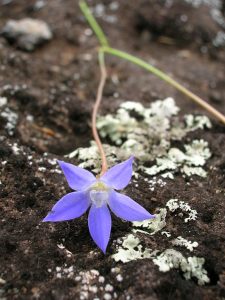Gardening with Indigenous Plants
Indigenous Plant Use
Identification & Control of Common Weeds
| Botanical Name: | Wahlenbergia gracilis 4 synonyms: Campanula gracilis, Cervicina gracilis, Lightfootia gracilis, Wahlenbergia vinciflora |
| Common Name: | australian bluebell, sprawling bluebell |
| Sold As: | Tube ($2.00) |
| Plant Type(s): | Ground Cover (up to 30 cm), Low Growing Shrub (30 cm to 1 m), Butterfly Attracting, Insect Attracting |
| Growing Conditions: | Full Sun, Partial Shade
Moist, Wet, Well Drained |
| Size (HxW): | 10-60 cm x 0.3-1 m |
| Foliage: | Scattered narrow leaves 3-70 mm x 1-10 mm, leaves at base often paired, broader and toothed. |
| Flowers: | Tiny soft bell-shaped Blue with white style flowers to the end of stems. Petals are edible, September-February |
| General Comments: | Erect to sprawling tufted perennial herb, many-branched from a few basal stems. Plants often die back in summer to a thick taproot. Dainty little herb which will seed freely in some gardens. Spreads readily. Nectar for butterflies. |
 Further Information: | |
| Plant Propagation: | The fruits are papery capsules that change from green to tan brown, and become brittle when seed is ripe. Most capsules contain many fine seeds, although, not all seed will be fertile. Seed collection is most common through summer. The seed matures 3-4 weeks after flowering. Cut the stalks with capsules and place upside down in paper bags. Allow to dry in a warm spot. Lightly beat or crush capsules to release the fine red-brown seed. Sieve to clean. Seed from some areas may have a 4-6 months after-ripening period. |




